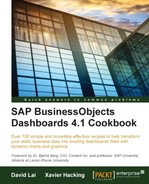What about using live data from your Salesforce.com reports in SAP BusinessObjects Dashboards to create interactive dashboards to show, track, and analyze your sales activities? DashConn is an add-on by IdeaCrop for SAP BusinessObjects Dashboards that delivers this integration. Let's have a look at the features of this add-on and how to set it up.
As we are connecting to Salesforce.com, you will obviously need a Salesforce.com Developer account. You can sign up for a free account at http://developer.salesforce.com/signup.
To connect to Salesforce.com from a dashboard in SAP BusinessObjects Dashboards, you will require a security token. You can get this security token from the Personal Setup menu at Salesforce.com.

You can download a free trial version of the DashConn add-on from the IdeaCrop website, http://www.ideacrop.com/.
- Open a new SAP BusinessObjects Dashboards file and drag the Salesforce.com DataViewer component onto the canvas.
- Go to the Reports tab and enter your Salesforce.com credentials. A list with your Salesforce.com reports will appear.

- Select the report you want to use. A loading message will appear.
- Now go to the Data Output tab and bind the Main result destination field to spreadsheet cell range A6:D20.

- Bind the Selection destination field to cell range G6:K20.
- Make sure that the Place column names in the first row option is selected. We can use these column names later on when we add some chart components and have to bind the series names.
- Preview the dashboard to see how the data is being returned (and filled in the spreadsheet cells that we bound in step 4). You will be asked to fill in your credentials.

- Leave the Preview mode and drag a Column Chart component to the canvas.
- Bind the Column Chart component to the columns you want to show in the chart. Remember that the first row will show the column names. Also, do not forget to select the Ignore Blank Cells options in the Behavior tab of the chart component. In this recipe example, we are showing two series: Actual Costs and Budgeted Costs.
- Now add another chart to the canvas and bind it to one or more columns from the Selection destination area (step 5). In this recipe example, we want to show the Total Leads in a Bar Chart.
- Preview the dashboard. As you will see, the Column Chart will display data right away. If you select a row in the Salesforce.com DataViewer component, the Bar Chart will also be filled.

- Leave the Preview mode and add a Horizontal Slider component to the canvas.
- Bind the Data field of this component to cell C1.
- Select the Salesforce.com DataViewer component again and go to the Data Output tab.
- We want to filter the records based on the value in the Total Responses column. To do this, select the correct column from the Prompt Column selector and bind the Prompt Value field to cell C1. For the Prompt Operator selector, we select greaterOrEqual.

- Preview the dashboard once more.

The Salesforce.com DataViewer component does most of the work for us. As you have seen, we only had to enter our Salesforce.com credentials, select a report, and preview the dashboard to see how the data will be returned. After binding the fields of the Data Output tab, we can reuse the report data in other components.
The Salesforce.com DataViewer component has some nice runtime features to drill down or up in the report data, open the Salesforce.com details page of all selected items, set filters, and aggregate data by a certain field. With these options, you can dynamically change the data being retrieved by the Salesforce.com DataViewer component. This also means that the values in spreadsheet cells that are bound to the Main result destination field in the Data Output tab change as well.
To conclude this recipe, we will discuss two more options: the Data Manager Connection and Working Mode settings.
A very nice feature of this add-on is that it also has a Connection option that is available from the Data Manager. With this Connection, you can use Salesforce.com report data in your dashboards without having to use the Salesforce.com DataViewer component. Another important feature of the Connection option is that it offers the ability to constantly refresh data from Salesforce.com reports—just like other Connection options—without being prompted for credentials.
Except for the Usage tab, most settings are similar to those of the Salesforce.com DataViewer component.

In the Behavior tab of the component and Data Manager Connection, you can find the Working Mode setting, as seen in the following screenshot. In the default Online setting, an Internet connection is required to use the component to connect to Salesforce.com. In Offline mode, the (first level of) report data is embedded within the dashboard.
The third Online/ fallback to Offline mode is a combination of the online and offline modes and will try to retrieve live data first; but if this fails, it uses the embedded data.

